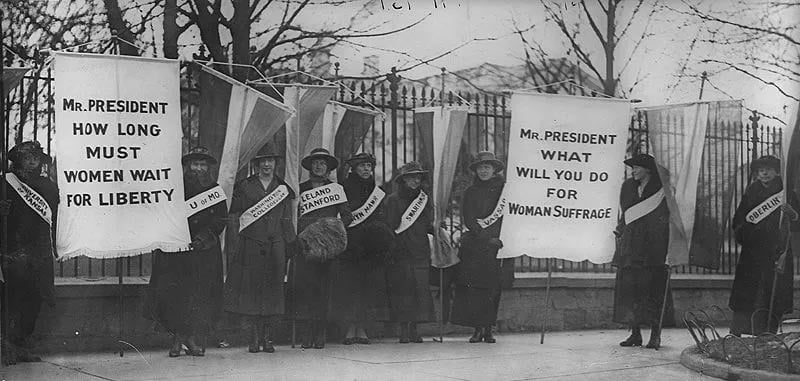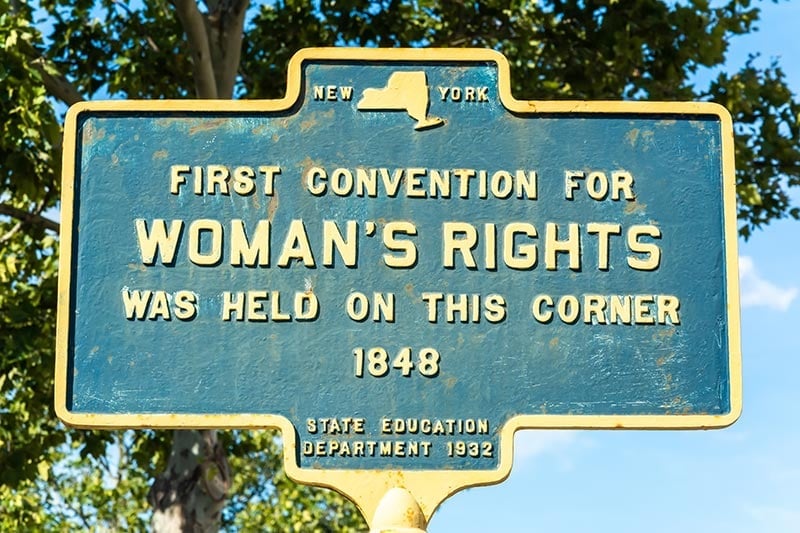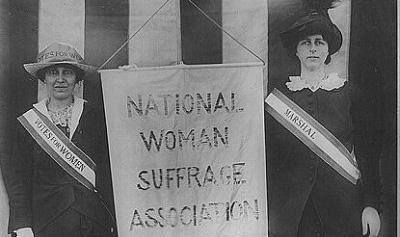The first wave of feminism was a period of the feminist movement that occurred during the 19th and early 20th centuries in Western countries.
The first wave is usually tied to the first formal Women’s Rights Convention held in 1848, which was thought to have ended around 1920.

Throughout this period, women advocated for social and constitutional equal rights to white men. Their goals revolved around having the right to vote, education, own property, and be legally recognized as citizens independent from their husbands.
The feminist movement at this time would address working women’s issues and earning a higher education at times. Still, most of the movement’s efforts concentrated on obtaining the right to vote.
This was important because women would not be viewed as equal citizens in society without the right to vote.
The history of first-wave feminism
The first wave of feminism is believed to have started around 1848, often tied to the first formal Women’s Rights Convention in Seneca Falls, New York. The convention was notably run by Lucretia Mott and Elizabeth Cady Stanton, who were among the other 300 in attendance.
Stanton declared that all men and women were created equal, and thus, she advocated for women’s education, their right to own property, and organizational leadership.
Many of the activists believed that their goals would be hard to accomplish without women’s right to vote. Thus, for the following 70 years, this was the main goal.

The first wave of feminism coincided with the abolitionist movement in the United States when activism fought for the abolition of slavery.
A key figure of the feminist movement, Elizabeth Cady Stanton, found that she and other women at an abolitionist convention were not allowed a place on the floor of the meeting with the men. Stanton considered this discrimination against women a turning point (Davis, 2010).
Along with Lucretia Mott, Stanton held the first Women’s Rights Convention at Seneca Falls in 1848. Stanton authored ‘The Declaration of Sentiments,’ which expanded on the Declaration of Independence by adding the word ‘woman’ or ‘women’ throughout.
The ‘Declaration of Sentiments’ called for broader educational and professional opportunities for women and the right for married women to control their wages and to own property. However, their central goal became the voting rights of women.
Formerly enslaved person and leader of the abolition movement, Frederick Douglass also attended the convention at Seneca Falls and was an advocate for women’s rights. Several black women supported the suffrage movement, organizing groups such as the National Association of Colored Women (NACW). Prominent African American suffragist Ida B. Wells also led a crusade against lynching.
In 1851, Stanton met Susan B. Anthony, and they became good friends and worked together for over 50 years fighting for women’s rights. They traveled the country together and gave speeches demanding that women be granted the right to vote.
Meanwhile, the first mass women’s suffrage petition in the United Kingdom was sent to the House of Commons in 1866. Petitions and meetings were used to persuade the parliament members to support their cause.

There was a dispute in the suffrage movement regarding the 14th and 15th amendments to the US Constitution, which gave voting rights to black men. Stanton and Anthony opposed this amendment and disagreed that black men should have the right to vote before women.
This view resulted in disagreements in the suffrage movement. It prompted Stanton and Anthony to found the National Woman Suffrage Association (NWSA) in 1869, whereas other suffragists founded the American Woman Suffrage Association (AWSA).
After more than two decades of operating independently, the NWSA merged with the AWSA to form the National American Woman Suffrage Association (NAWSA) in 1890 (Davis, 2010).
In 1897, in the U.K., seventeen suffrage societies were united to create the National Union of Women’s Suffrage Societies (NUWSS). The leader of this was politician and writer Millicent Fawcett.
The NUWSS was viewed as unsuccessful, so in 1903, Emmeline Pankhurst set up the Women’s Social and Political Union (WSPU) in Manchester. The WSPU became known for employing more ‘militant’ strategies to gain suffrage, such as arson and hunger strikes, many of whom ended up in prison. The women of the movement became known as the suffragettes (Van Wingerden, 1999).
One of the most notable ‘militant’ feminists was suffragette Emily Davidson who was sent to prison several times for her activism. In 1913, she died as she stepped in front of the King’s horse at the Epsom Derby, causing her to be trampled by a horse. From then on, the word ‘militant’ became symbolic of media depictions of suffragists’ actions.
As the movement developed, reproductive rights became a significant issue for women. In 1916, Margaret Sanger opened the first birth control clinic in the United States.
This move was made in defiance of the New York state law that forbade the distribution of contraception. Sanger would later go on to found the clinic that became Planned Parenthood.

In 1918 in the UK, the Representation of the People Bill was passed, meaning that women over the age of 30 and men over the age of 21 were granted the right to vote. All women over 21 in the UK could vote from 1928. In the US, women were allowed to vote from August 1920. The vote was granted at different times for other Western countries, such as in 1918 for Canada and Germany, and not until 1944 for France.
After 1920, the momentum of the feminist movement began to dwindle after this massive success. However, other activists continued to advocate for their rights within local organizations and special interest groups.
What was achieved by first-wave feminism?
The most notable achievements of first-wave feminism were due to the suffrage movement. The 19th Amendment to the United States Constitution granted women the right to vote in 1920 by stipulating that the right to vote could not be denied because of sex.
Likewise, the suffrage movement in Britain won a complete victory when the Equal Franchise Act of 1928 allowed all adult women over 21 to vote.
Married Women’s Property Acts in the US and UK expanded the rights of married women to acquire, hold, use, and dispose of their separate property. Before this, a women’s property became her husband’s upon marriage. This act was gradually enforced in the US from 1839 and became UK law in 1882.
Criticisms of first-wave feminism
One of the biggest criticisms of the first wave of feminism is that the focus was primarily on the rights of white, western, middle-class women.
It is misleading to assume that the women who fought for suffrage did so as a homogenous group simply because they were all women. Factors such as political stance, religion, and social class would have shaped how much involvement women would have in the movement.
In reality, some of the more conservative women in the movement adopted a segregationist approach that prioritized the voting rights of white women over Black men and women.
Many Black women were excluded from the suffrage movement or had to form their own suffrage groups. In some marches, Black women were often made to march behind white women (Duster, 2019).
The struggles of Black women, who faced additional discrimination for their race and being women, were often ignored. When abolitionist Sojourner Truth delivered her famous ‘Aint I a Woman’ speech at the women’s rights convention in 1851, many white women wanted her to be silenced, fearing that she would divert attention away from women’s suffrage (Crenshaw, 1989).
In many cases during this wave of feminism, white feminists have fought for white women’s rights while being complicit with structural racism (Brewer, 2020). Elizabeth Cady Stanton notably opposed the amendment, which granted Black men the right to vote. Stanton, among others, argued that Black men should not be permitted to vote before white women, often using racial discrimination to push for their own rights (Davis, 1981).
Even after the vote was granted to American women in 1920, voters had to pay a fee or complete literacy tests to vote, which means that those who were poorer or without a high enough level of education would not have been able to vote.
At the time, this would have meant that African Americans in poorer communities would face barriers to voting. It would not be until the Voting Rights Act of 1965 removed any such barrier that may have stopped someone from casting their vote.
Frequently Asked Questions
What type of feminism is most associated with the first wave?
The main branch of feminism associated with the goals of first-wave feminists is liberal feminism. Liberal feminism is focused on achieving gender equality through political and legal reform within the systems already in place. Advocating for women’s right to vote, so they have the same rights as men is a liberal feminist goal.
What is a famous piece of first-wave literature?
First-wave feminism is thought to have been partly inspired by early feminist writer Mary Wollstonecraft.
Her writing titled ‘The Vindication of the Rights of Women’ from 1792 was written in the wake of the French Revolution (Krolokke & Sorensen, 1996).
Wollstonecraft argued for girls and women to be allowed the same educational opportunities as men so they would be better wives, mothers, and capable workers.
Did the first wave of feminism occur globally?
Although the effects of first-wave feminism have been felt across the globe regarding achieving women”s voting rights, the activism did not occur globally during this period.
The first wave of feminism in the 19th and 20th centuries transpired in western countries, primarily in the United States and Western Europe.
References
Brewer, R. M. (2020). Black feminism and womanism. Companion to feminist studies, 91-104.
Cowman, K. (2000). Women”s suffrage campaigns in Britain. Women”s History Review, 9 (4), 815-823.
Crenshaw, K. (1989). Demarginalizing the intersection of race and sex: A black feminist critique of antidiscrimination doctrine, feminist theory, and antiracist politics. In Feminist Legal Theories (pp. 23-51). Routledge.
Davis, A. Y. (1981). Women, race, and class. Vintage.
Davis, S. (2010). The political thought of Elizabeth Cady Stanton: women”s rights and the American political traditions. NYU Press.
Duster, M. (2019). From the Suffrage Movement to the Women”s March: Black Women”s Fight for Inclusion. Black History Bulletin, 82 (2), 10-11.
Krolokke, C., & Sorensen, A. S. (2006). Three waves of feminism: From suffragettes to grrls. Gender communication theories & analyses: From silence to performance, 1-25.
Van Wingerden, S. A. (1999). The women”s suffrage movement in Britain, 1866-1928. Palgrave Macmillan.

